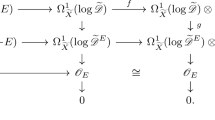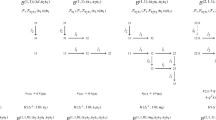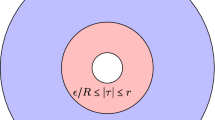Abstract
Given a smooth toric variety \(X\), the action of the torus \(T\) lifts to the moduli space \({\mathcal {M}}\) of stable sheaves on \(X\). Using the pioneering work of Klyacho, a fairly explicit combinatorial description of the fixed point locus \({\mathcal {M}}^T\) can be given (as shown by earlier work of the author). In this paper, we apply this description to the case of torsion free sheaves on a smooth toric surface \(S\). A general expression for the generating function of the Euler characteristics of such moduli spaces is obtained. The generating function is expressed in terms of Euler characteristics of certain moduli spaces of stable configurations of linear subspaces appearing in classical GIT. The expression holds for any choice of \(S\), polarization, rank, and first Chern class. Specializing to various examples allows us to compute some new as well as known generating functions.
Similar content being viewed by others
Notes
For the definition of Gieseker stability, see [12, Def. 1.2.4].
Recall that the notion of stability depends on the choice of polarization.
In this paper, we work with varieties, schemes, and stacks over ground field \({\mathbb {C}}\).
For the definition of \(\mu \)-stability, also known as slope or Mumford-Takemoto stability, see [12, Def. 1.2.12].
Configurations of linear subspaces and their moduli spaces are a classical topic in GIT. See [4, Ch. 11] for a discussion.
This example was considered independently around the same time by Weist using techniques of toric geometry and quivers [29].
We always assume \(\Delta \) contains cones of dimension \(d\).
For gluing conditions for general \(T\)-equivariant coherent sheaves see [26, Sect. 5.2].
The precise statement is this. The category of \(T\)-equivariant torsion free sheaves on \(U_{\sigma _i}\) is equivalent to the category of finite \(\sigma _i\)-families with all maps \(\chi _{m,m'}^{\sigma _i}\) injective. This category is equivalent to its full subcategory of finite \(\sigma _i\)-families with all maps \(\chi _{m,m'}^{\sigma _i}\) inclusions.
It should be clear how the gluing conditions read when the rays of \(\sigma _i \cap \sigma _j\) do not necessarily correspond to the first \(p\) rays of \(\sigma _i\) and \(\sigma _j\).
Large parts of this section hold for \(T\)-equivariant pure sheaves in general [20].
As usual, two such families \(\mathcal {F}_{1}\), \(\mathcal {F}_{2}\) are identified if there exists a line bundle \(L\) on \(S\) and a \(T\)-equivariant isomorphism \(\mathcal {F}_{1} \cong \mathcal {F}_{2} \otimes p_{S}^{*}L\). See [20, Sect. 3.1] for details.
In the previous sections, we followed Perling’s convention of ascending directions for the maps between the weight spaces as opposed to Klyachko’s convention of descending directions. This results in some minus signs compared to Klyachko’s original formula.
Note that for any finite product of Grassmannians \(\prod _{i} \mathrm{Gr}(n_{i},N)\), the map \(\{p_{i}\}_i \mapsto \mathrm{dim}\left( \bigcap _{i} p_{i} \right) \) is upper semicontinuous.
The terminology “wall” might be slightly confusing in this context as \(W\) lies dense in \({\mathbb {Q}}_{>a}\).
The cited theorem also holds for \(\mu \)-stability instead of Gieseker stability.
In the case \(f_3=f_4=0 \mod 2\), we have \(\Lambda = \varnothing \). However, for \(r=2\) and fixed \(c_1, c_2\) one can show that \(\mathrm{Obj}_{ss}^{\mathrm{ch}}(\mu ) \setminus \mathrm{Obj}_{s}^{\mathrm{ch}}(\mu )\) is the same for any polarization not on a wall of type \((c_1,c_2)\). Therefore, formula (14) also holds in this case, because strictly \(\mu \)-semistables on either side of a wall cancel (compare [9, Thm. 2.9]).
During the final preparations of the first version of this paper, the author found out about recent independent work of Weist [29], which also computes the case \(r=3\) and \(S = {\mathbb {P}}^{2}\) using techniques of toric geometry and quivers. Weist has communicated to the author that his results are consistent with the expansions given at the end of this section.
References
Bruzzo, U., Poghossian, R., Tanzini, A.: Poincaré polynomial of moduli spaces of framed sheaves on (stacky) Hirzebruch surfaces. Commun. Math. Phys. 304, 395–409 (2011)
Choi, J.: Genus Zero BPS Invariants for Local \({\mathbb{P}}^1\), IMRN advance access (2012)
Choi, J., Maican, M.: Torus action on the moduli spaces of plane sheaves, arXiv:1304.4871
Dolgachev, I.: Lectures on Invariant Theory. Cambridge University Press, Cambridge (2003)
Ellingsrud, G., Strømme, S.A.: On the homology of the Hilbert scheme of points in the plane. Invent. Math. 87, 343–352 (1987)
Fulton, W.: Introduction to Toric Varieties. Princeton University Press, Princeton (1993)
Gómez, T.L.: Algebraic stacks. Proc. Indian Acad. Sci. Math. Sci. 111, 1–31 (2001)
Göttsche, L.: The Betti numbers of the Hilbert scheme of points on a smooth projective surface. Math. Ann. 286, 193–207 (1990)
Göttsche, L.: Change of polarization and Hodge numbers of moduli spaces of torsion free sheaves on surfaces. Math. Z. 223, 247–260 (1996)
Göttsche, L.: Theta functions and Hodge numbers of moduli spaces of sheaves on rational surfaces. Commun. Math. Phys. 206, 105–136 (1999)
Hartshorne, R.: Stable reflexive sheaves. Math. Ann. 254, 121–176 (1980)
Huybrechts, D., Lehn, M.: The Geometry of Moduli Spaces of Sheaves. Vieweg, Braunschweig (1997)
Joyce, D.: Motivic invariants of Artin stacks and ‘stack functions’. Q. J. Math. 58, 345–392 (2007)
Joyce, D.: Configurations in abelian categories. IV. Invariants and changing stability conditions. Adv. Math. 217, 125–204 (2008)
Kaneyama, T.: On equivariant vector bundles on an almost homogeneous variety. Nagoya Math. J. 57, 65–86 (1975)
Klyachko, A.A.: Toric bundles and problems of linear algebra. Funct. Anal. Appl. 23, 135–137 (1989)
Klyachko, A.A.: Equivariant bundles on toral varieties. Math. USSR Izvestiya 35, 337–375 (1990)
Klyachko, A.A.: Stable bundles, representation theory and Hermitian operators. Sel. Math. 4, 419–445 (1998)
Klyachko, A.A.: Vector Bundles and Torsion Free Sheaves on the Projective Plane, preprint Max Planck Institut für Mathematik (1991)
Kool, M.: Fixed point loci of moduli spaces of sheaves on toric varieties. Adv. Math. 227, 1700–1755 (2011)
Kool, M.: Moduli spaces of sheaves on toric varieties, D.Phil. thesis University of Oxford (2010)
Manschot, J.: The Betti numbers of the moduli space of stable sheaves of rank 3 on \({\mathbb{P}}^2\). Lett. Math. Phys. 98, 65–78 (2011)
Manschot, J.: BPS invariants of \(N=4\) gauge theory on a surface. Commun. Num. Theor. Phys. 6, 497–516 (2012)
Manschot, J.: BPS invariants of semi-stable sheaves on rational surfaces. arXiv:1109.4861
Mozgovoy, S.: Invariants of moduli spaces of stable sheaves on ruled surfaces. arXiv:1302.4134
Perling, M.: Graded rings and equivariant sheaves on toric varieties. Math. Nachr. 263–264, 181–197 (2004)
Qin, Z.: Equivalence classes of polarizations and moduli spaces of sheaves. J. Diff. Geom. 37, 397–413 (1993)
Vakil, R.: Murphy’s law in algebraic geometry: badly-behaved deformation spaces. Invent. Math. 164, 569–590 (2006)
Weist, T.: Torus fixed points of moduli spaces of stable bundles of rank three. J. Pure Appl. Algebra 215, 2406–2422 (2011)
Yoshioka, K.: The Betti numbers of the moduli space of stable sheaves of rank 2 on \({\mathbb{P}}^{2}\). J. Reine Angew. Math. 453, 193–220 (1994)
Acknowledgments
Many of the guiding ideas of this paper come from Klyachko’s wonderful preprint [19]. I would like to thank Tom Bridgeland, Frances Kirwan, Sven Meinhardt, Yinan Song, Balázs Szendrői, Yukinobu Toda and Richard Thomas for useful discussions and my supervisor Dominic Joyce for his continuous support. The author would also like to thank the referee very useful suggestions on improving the exposition of this paper. This paper is part of the author’s D.Phil. project funded by an EPSRC Studentship, which is part of EPSRC Grant EP/D077990/1.
Author information
Authors and Affiliations
Corresponding author
Rights and permissions
About this article
Cite this article
Kool, M. Euler characteristics of moduli spaces of torsion free sheaves on toric surfaces. Geom Dedicata 176, 241–269 (2015). https://doi.org/10.1007/s10711-014-9966-2
Received:
Accepted:
Published:
Issue Date:
DOI: https://doi.org/10.1007/s10711-014-9966-2




